Carbon Emissions Intensity of the Transportation Sector in China: Spatiotemporal Differentiation, Trends Forecasting and Convergence Characteristics
Abstract
1. Introduction
2. Materials and Methods
2.1. Accounting of TSCEI in China
2.2. Dagum Gini Coefficient
2.3. Spatial Autocorrelation Analysis
2.4. Spatial Markov Chain
2.5. The Method of Convergence Trends Analysis
2.5.1. Convergence Analysis
2.5.2. Absolute Convergence Analysis
2.5.3. Conditional Convergence Analysis
2.6. Data Sources
3. Empirical Results
3.1. Basic Factual Characteristics: Accounting Results of TSCEI
3.1.1. Temporal Evolution of TSCEI in China
3.1.2. Spatial Distribution Trends of TSCEI in China
3.2. Spatial Inequality and Spatial Autocorrelation of TSCEI in China
3.2.1. Measurement and Decomposition of Spatial Differences of TSCEI in China
3.2.2. Spatial Autocorrelation Analysis of TSCEI in China
3.3. Evolutionary Trend Forecasting of TSCEI in China
3.3.1. Dynamic Transfer Trend of TSCEI in China
3.3.2. Future Trend Forecasting of TSCEI in China
3.4. Spatial Convergence Analysis of TSCEI in China
3.4.1. Convergence Analysis of TSCEI in China
3.4.2. Absolute Convergence Analysis of TSCEI in China
3.4.3. Conditional Convergence Analysis of TSCEI in China
4. Conclusions and Policy Implications
4.1. Conclusions
- (1)
- The TSCEI in China declined from 2.8760 tons per CNY in 2015 to 1.9249 tons per CNY in 2022, with an average of 2.4468 tons per CNY, reflecting nationwide efforts to reduce transportation carbon emissions. All regions in China experienced a downward trend in TSCEI. However, spatial inequality persists, with a distinct “higher in the north and west, lower in the south and east” distribution pattern;
- (2)
- Inter-regional differences are the dominant contributor to the overall TSCEI differences, especially for the inter-regional differences between the northeast and both the eastern and central regions. Provincial TSCEI exhibited significant spatial positive correlation and increasing spatial association. Local spatial autocorrelations were primarily in H-H and L-L agglomeration patterns, concentrated in western and specific eastern provinces, respectively;
- (3)
- The state transfers of TSCEI in China exhibit a notable degree of stability, with leapfrog improvements in provincial TSCEI being difficult to achieve in adjacent years. Geospatial patterns play a crucial role in the spatiotemporal evolution of TSCEI, with pronounced spatial spillover effects. In terms of long-term evolutionary trends, provincial TSCEI gradually shifts from high- to low-intensity states over time, with an equilibrium probability of 90.98% for transferring to a lower-intensity state under the premise of maintaining current policies. Additionally, the influences of different neighboring states on the long-term evolution of TSCEI demonstrate significant heterogeneity;
- (4)
- TSCEI at both national and regional levels displayed trends of convergence and convergence. In tests for absolute convergence, the eastern and western regions exhibited higher convergence rates. After controlling for other heterogeneity variables, the conditional convergence rates at national and regional levels improved to varying extents. Additionally, the introducing spatial effects in the absolute and conditional convergence models revealed regional heterogeneity. Notably, transportation energy structure and technological progress—especially technological progress—are crucial in promoting convergence towards lower TSCEI values at both national and regional levels.
4.2. Policy Implications
- (1)
- Strengthening regional collaborative development strategies to promote the reduction in TSCEI—Significant inter-regional differences serve as the primary drivers of the overall TSCEI differences. This phenomenon is closely associated with the country’s intricate economic spatial distribution. Therefore, while promoting the low-carbon transformation of the transportation sectors in the eastern and central regions, greater emphasis must be placed on expediting TSCEI reduction in the western and northeastern regions. On the one hand, enhanced policy support should be directed towards the western and northeastern regions, encompassing the development of green transportation infrastructure, the optimization of transportation structures, the adoption of new energy and clean energy vehicles, and innovation in green transportation technologies. On the other hand, leveraging the demonstration and spatial radiation effects of the eastern and central regions in low-carbon transportation development—particularly in provinces such as Hebei, Anhui, Henan, and Shandong—can catalyze the low-carbon transformation of transportation in other provinces. Furthermore, it is crucial to establish cooperative mechanisms for transportation carbon reduction across neighboring provinces, urban clusters, economic zones, and major national strategic areas;
- (2)
- Narrowing intra-regional TSCEI differences and implementing region-specific transportation carbon reduction policies—Although in the long-term, TSCEI in China shows a trend towards a lower-intensity state and exhibits characteristics of both convergence and convergence, the current significant spatial inequality of TSCEI across China has hindered the achievement of transportation carbon reduction targets, while the finding of the contribution of transvariation density not only supports the rationale behind the regional divisions but also highlights the distinct development paths for low-carbon transportation across different regions. Therefore, transportation carbon reduction policies must be tailored to local conditions. Specially, in the eastern region, efforts should focus on optimizing travel patterns, promoting green mobility alternatives, and prioritizing multimodal transportation and new energy vehicles. In the central region, the emphasis should be on electrifying railways and developing clean energy public transit systems to reduce reliance on traditional energy-intensive transportation modes. In the western region, characterized by vast geographical areas and higher TSCEI levels, policies should focus on developing green energy-driven transportation systems, and improving rural and cross-regional freight networks to enhance connectivity while reducing carbon intensity. In the northeastern region, with its heavy industrial base and reliance on traditional energy-intensive transportation, efforts should prioritize the electrification of key freight corridors and the modernization of public transit systems. Additionally, cross-regional collaboration should be strengthened to facilitate the diffusion of technologies and best practices from low-TSCEI provinces to high-TSCEI provinces;
- (3)
- Adhering to an innovation-driven strategy by leveraging energy-efficiency technologies is essential to facilitate the convergence of TSCEI toward lower values. Given that the introduction of heterogeneity control variables, particularly transportation energy structure and technological progress under the condition of convergence, can significantly enhance convergence rates at both national and regional levels, there is an urgent need to foster innovation in energy-efficient technologies within the transportation sector. On one hand, establishing a government-led, market-driven approach to promoting the research and development (R&D), and application of energy-saving technologies within the transportation sector, while also creating a low-carbon transportation technology supply system tailored to the specific market demands of each province, leveraging innovations in energy-saving technologies to propel the development of low-carbon transportation, is crucial. On the other hand, considering the evolution of China’s transportation energy-consumption structure, it is crucial to accelerate the application of electricity, hydrogen, and renewable energy into the transportation sector. A market-driven approach should serve as the foundation for constructing a clean, low-carbon energy transformation pathway, which, by reducing transportation energy intensity, will release greater potential for decreasing TSCEI.
4.3. Future Outlook
Author Contributions
Funding
Institutional Review Board Statement
Informed Consent Statement
Data Availability Statement
Conflicts of Interest
References
- Liu, X.; Niu, Q.; Dong, S.; Zhong, S. How does renewable energy consumption affect carbon emission intensity? Temporal-spatial impact analysis in China. Energy 2023, 284, 128690. [Google Scholar] [CrossRef]
- Li, X.; Zhao, Z.; Zhao, Y.; Zhou, S.; Zhang, Y. Prediction of energy-related carbon emission intensity in China, America, India, Russia, and Japan using a novel self-adaptive grey generalized Verhulst model. J. Clean. Prod. 2023, 423, 138656. [Google Scholar] [CrossRef]
- Ke, N.; Chen, J.; Cheng, T. The drivers of carbon intensity and emission reduction strategies in heavy industry: Evidence from nonlinear and spatial perspectives. Ecol. Indic. 2024, 160, 111764. [Google Scholar] [CrossRef]
- IEA. Available online: https://www.iea.org/data-and-statistics/data-tools/greenhouse-gas-emissions-from-energy-data-explorer (accessed on 16 January 2025).
- Wang, Y.; Guo, C.-H.; Du, C.; Chen, X.-J.; Jia, L.-Q.; Guo, X.-N.; Chen, R.-S.; Zhang, M.-S.; Chen, Z.-Y.; Wang, H.-D. Carbon peak and carbon neutrality in China: Goals, implementation path and prospects. China Geol. 2021, 4, 720–746. [Google Scholar] [CrossRef]
- Li, Z.; Åhman, M.; Nilsson, L.J.; Bauer, F. Towards carbon neutrality: Transition pathways for the Chinese ethylene industry. Renew. Sustain. Energy Rev. 2024, 199, 114540. [Google Scholar] [CrossRef]
- Chen, J.; Feng, Y.; Zhang, Z.; Wang, Q.; Ma, F. Exploring the patterns of China’s carbon neutrality policies. J. Environ. Manag. 2024, 371, 123092. [Google Scholar] [CrossRef]
- Solaymani, S. CO2 emissions patterns in 7 top carbon emitter economies: The case of transport sector. Energy 2019, 168, 989–1001. [Google Scholar] [CrossRef]
- Peng, Z.; Li, M. What drives the spatial–temporal differentiation of transportation carbon emissions in China? Evidence based on the optimal parameter-based geographic detector model. Environ. Dev. Sustain. 2024, 1–31. [Google Scholar] [CrossRef]
- Meng, C.; Du, X.; Zhu, M.; Ren, Y.; Fang, K. The static and dynamic carbon emission efficiency of transport industry in China. Energy 2023, 274, 127297. [Google Scholar] [CrossRef]
- Lv, T.; Zhao, Q.; Fu, S.; Jin, G.; Zhang, X.; Hu, H.; Xu, G. Deciphering flows: Spatial correlation characteristics and factors influencing carbon emission intensity in the Yangtze River Delta. J. Clean. Prod. 2024, 483, 144290. [Google Scholar] [CrossRef]
- Zheng, S.; Yuan, R.; Li, N. Persistent mitigation efforts and implications for China’s emissions peak using statistical projections. Sci. Total Environ. 2022, 826, 154127. [Google Scholar] [CrossRef] [PubMed]
- Zheng, S.; Yuan, R. Sectoral convergence analysis of China’s emissions intensity and its implications. Energy 2023, 262, 125516. [Google Scholar] [CrossRef]
- Jobert, T.; Karanfil, F.; Tykhonenko, A. Convergence of per capita carbon dioxide emissions in the EU: Legend or reality? Energy Econ. 2010, 32, 1364–1373. [Google Scholar] [CrossRef]
- Yu, S.; Hu, X.; Fan, J.-l.; Cheng, J. Convergence of carbon emissions intensity across Chinese industrial sectors. J. Clean. Prod. 2018, 194, 179–192. [Google Scholar] [CrossRef]
- Huang, J.; Liu, C.; Chen, S.; Huang, X.; Hao, Y. The convergence characteristics of China’s carbon intensity: Evidence from a dynamic spatial panel approach. Sci. Total Environ. 2019, 668, 685–695. [Google Scholar] [CrossRef]
- Liu, J.; Li, S.; Ji, Q. Regional differences and driving factors analysis of carbon emission intensity from transport sector in China. Energy 2021, 224, 120178. [Google Scholar] [CrossRef]
- Zhao, P.; Zeng, L.; Li, P.; Lu, H.; Hu, H.; Li, C.; Zheng, M.; Li, H.; Yu, Z.; Yuan, D.; et al. China’s transportation sector carbon dioxide emissions efficiency and its influencing factors based on the EBM DEA model with undesirable outputs and spatial Durbin model. Energy 2022, 238, 121934. [Google Scholar] [CrossRef]
- Domagała, J.; Kadłubek, M. Economic, Energy and Environmental Efficiency of Road Freight Transportation Sector in the EU. Energies 2023, 16, 461. [Google Scholar] [CrossRef]
- Liu, J.-B.; Liu, B.-R.; Lee, C.-C. Efficiency evaluation of China’s transportation system considering carbon emissions: Evidence from big data analytics methods. Sci. Total Environ. 2024, 922, 171031. [Google Scholar] [CrossRef]
- Fang, T.; Fang, D.; Yu, B. Carbon emission efficiency of thermal power generation in China: Empirical evidence from the micro-perspective of power plants. Energy Policy 2022, 165, 112955. [Google Scholar] [CrossRef]
- Xia, W.; Ma, Y.; Gao, Y.; Huo, Y.; Su, X. Spatial-temporal pattern and spatial convergence of carbon emission intensity of rural energy consumption in China. Environ. Sci. Pollut. Res. 2024, 31, 7751–7774. [Google Scholar] [CrossRef]
- Ke, N.; Lu, X.; Zhang, X.; Kuang, B.; Zhang, Y. Urban land use carbon emission intensity in China under the “double carbon” targets: Spatiotemporal patterns and evolution trend. Environ. Sci. Pollut. Res. 2023, 30, 18213–18226. [Google Scholar] [CrossRef] [PubMed]
- Liu, Q.; Song, J.; Dai, T.; Shi, A.; Xu, J.; Wang, E. Spatio-temporal dynamic evolution of carbon emission intensity and the effectiveness of carbon emission reduction at county level based on nighttime light data. J. Clean. Prod. 2022, 362, 132301. [Google Scholar] [CrossRef]
- Zeng, G.; Guo, Y.; Nie, S.; Liu, K.Y.; Cao, Y.; Chen, L.; Ren, D.Z.; Zhang, J.Q.; Yan, B.W. Spatial characteristic of carbon emission intensity under “dual carbon” targets: Evidence from China. Glob. Nest J. 2024, 26. [Google Scholar] [CrossRef]
- Yan, J.; Su, B.; Liu, Y. Multiplicative structural decomposition and attribution analysis of carbon emission intensity in China, 2002–2012. J. Clean. Prod. 2018, 198, 195–207. [Google Scholar] [CrossRef]
- De Oliveira-De Jesus, P.M. Effect of generation capacity factors on carbon emission intensity of electricity of Latin America & the Caribbean, a temporal IDA-LMDI analysis. Renew. Sustain. Energy Rev. 2019, 101, 516–526. [Google Scholar]
- Pan, X.F.; Guo, S.C.; Xu, H.T.; Tian, M.Y.; Pan, X.Y.; Chu, J.H. China’s carbon intensity factor decomposition and carbon emission decoupling analysis. Energy 2022, 239, 122175. [Google Scholar] [CrossRef]
- Mirziyoyeva, Z.; Salahodjaev, R. Renewable energy and CO2 emissions intensity in the top carbon intense countries. Renew. Energy 2022, 192, 507–512. [Google Scholar] [CrossRef]
- Dong, F.; Yu, B.L.; Hadachin, T.; Dai, Y.J.; Wang, Y.; Zhang, S.N.; Long, R.Y. Drivers of carbon emission intensity change in China. Resour. Conserv. Recycl. 2018, 129, 187–201. [Google Scholar] [CrossRef]
- Pan, X.F.; Uddin, M.K.; Ai, B.W.; Pan, X.Y.; Saima, U. Influential factors of carbon emissions intensity in OECD countries: Evidence from symbolic regression. J. Clean. Prod. 2019, 220, 1194–1201. [Google Scholar] [CrossRef]
- Xu, J.H.; Li, Y.Y.; Hu, F.; Wang, L.; Wang, K.; Ma, W.H.; Ruan, N.; Jiang, W.Z. Spatio-Temporal Variation of Carbon Emission Intensity and Spatial Heterogeneity of Influencing Factors in the Yangtze River Delta. Atmosphere 2023, 14, 163. [Google Scholar] [CrossRef]
- Zhao, X.; Xu, H.; Yin, S.; Zhou, Y. Threshold effect of technological innovation on carbon emission intensity based on multi-source heterogeneous data. Sci. Rep. 2023, 13, 19054. [Google Scholar] [CrossRef]
- Yi, M.; Chen, D.; Wu, T.; Tao, M.; Sheng, M.S.; Zhang, Y. Intelligence and carbon emissions: The impact of smart infrastructure on carbon emission intensity in cities of China. Sustain. Cities Soc. 2024, 112, 105602. [Google Scholar] [CrossRef]
- Jiang, L.; Yang, L.; Wu, Q.; Zhang, X. How does extreme heat affect carbon emission intensity? Evidence from county-level data in China. Econ. Model. 2024, 139, 106814. [Google Scholar] [CrossRef]
- Du, Z.; Xu, J.; Lin, B. What does the digital economy bring to household carbon emissions?—From the perspective of energy intensity. Appl. Energy 2024, 370, 123613. [Google Scholar] [CrossRef]
- Fan, F.; Lei, Y. Decomposition analysis of energy-related carbon emissions from the transportation sector in Beijing. Transp. Res. Part D Transp. Environ. 2016, 42, 135–145. [Google Scholar] [CrossRef]
- Li, R.; Li, L.; Wang, Q. The impact of energy efficiency on carbon emissions: Evidence from the transportation sector in Chinese 30 provinces. Sustain. Cities Soc. 2022, 82, 103880. [Google Scholar] [CrossRef]
- Huang, F.; Zhou, D.; Wang, Q.; Hang, Y. Decomposition and attribution analysis of the transport sector’s carbon dioxide intensity change in China. Transp. Res. Part A Policy Pract. 2019, 119, 343–358. [Google Scholar] [CrossRef]
- Pettersson, F.; Maddison, D.; Acar, S.; Söderholm, P. Convergence of Carbon Dioxide Emissions: A Review of the Literature. Int. Rev. Environ. Resour. Econ. 2014, 7, 141–178. [Google Scholar] [CrossRef]
- Zhu, Y.; Liang, D.; Liu, T. Can China’s underdeveloped regions catch up with green economy? A convergence analysis from the perspective of environmental total factor productivity. J. Clean. Prod. 2020, 255, 120216. [Google Scholar] [CrossRef]
- Rodríguez-Benavides, D.; Andrés-Rosales, R.; Álvarez-García, J.; Bekun, F.V. Convergence of clubs between per capita carbon dioxide emissions from fossil fuels and cement production. Energy Policy 2024, 186, 114007. [Google Scholar] [CrossRef]
- Kounetas, K.E.; Polemis, M.L.; Tzeremes, N.G. Measurement of eco-efficiency and convergence: Evidence from a non-parametric frontier analysis. Eur. J. Oper. Res. 2021, 291, 365–378. [Google Scholar] [CrossRef]
- Sun, H.; Kporsu, A.K.; Taghizadeh-Hesary, F.; Edziah, B.K. Estimating environmental efficiency and convergence: 1980 to 2016. Energy 2020, 208, 118224. [Google Scholar] [CrossRef]
- Liddle, B.; Sadorsky, P. Energy efficiency in OECD and non-OECD countries: Estimates and convergence. Energy Effic. 2021, 14, 19. [Google Scholar] [CrossRef]
- Apergis, N.; Payne, J.E.; Rayos-Velazquez, M. Carbon Dioxide Emissions Intensity Convergence: Evidence From Central American Countries. Front. Energy Res. 2020, 7, 7. [Google Scholar] [CrossRef]
- Zhang, C.; Dong, X.; Zhang, Z. Spatiotemporal Dynamic Distribution, Regional Differences and Spatial Convergence Mechanisms of Carbon Emission Intensity: Evidence from the Urban Agglomerations in the Yellow River Basin. Int. J. Environ. Res. Public Health 2023, 20, 3529. [Google Scholar] [CrossRef]
- Li, H.Z.; Li, B.K.; Liu, H.Y.; Zhao, H.R.; Wang, Y.W. Spatial distribution and convergence of provincial carbon intensity in China and its influencing factors: A spatial panel analysis from 2000 to 2017. Environ. Sci. Pollut. Res. 2021, 28, 54575–54593. [Google Scholar] [CrossRef]
- Chen, X.; Shuai, C.; Wu, Y.; Zhang, Y. Analysis on the carbon emission peaks of China’s industrial, building, transport, and agricultural sectors. Sci. Total Environ. 2020, 709, 135768. [Google Scholar] [CrossRef]
- Gu, Y.; Li, C. Shanghai Transport Carbon Emission Forecasting Study Based on CEEMD-IWOA-KELM Model. Sustainability 2024, 16, 8140. [Google Scholar] [CrossRef]
- Demir, A.S. Modeling and forecasting of CO2 emissions resulting from air transport with genetic algorithms: The United Kingdom case. Theor. Appl. Climatol. 2022, 150, 777–785. [Google Scholar] [CrossRef]
- Tan, J.; Peng, S.; Liu, E. Spatio-temporal distribution and peak prediction of energy consumption and carbon emissions of residential buildings in China. Appl. Energy 2024, 376, 124330. [Google Scholar] [CrossRef]
- Shan, Y.; Guan, D.; Zheng, H.; Ou, J.; Li, Y.; Meng, J.; Mi, Z.; Liu, Z.; Zhang, Q. China CO2 emission accounts 1997–2015. Sci. Data 2018, 5, 170201. [Google Scholar] [CrossRef] [PubMed]
- Dagum, C. A new approach to the decomposition of the Gini income inequality ratio. Empir. Econ. 1997, 22, 515–531. [Google Scholar] [CrossRef]
- Xie, P.; Duan, Z.; Wei, T.; Pan, H. Spatial disparities and sources analysis of co-benefits between air pollution and carbon reduction in China. J. Environ. Manag. 2024, 354, 120433. [Google Scholar] [CrossRef] [PubMed]
- Zhang, Q.; Li, J.; Li, Y.; Huang, H. Coupling analysis and driving factors between carbon emission intensity and high-quality economic development: Evidence from the Yellow River Basin, China. J. Clean. Prod. 2023, 423, 138831. [Google Scholar] [CrossRef]
- Xu, L.; Du, H.; Zhang, X. Driving forces of carbon dioxide emissions in China’s cities: An empirical analysis based on the geodetector method. J. Clean. Prod. 2021, 287, 125169. [Google Scholar] [CrossRef]
- Xu, M.; Bao, C. Quantifying the spatiotemporal characteristics of China’s energy efficiency and its driving factors: A Super-RSBM and Geodetector analysis. J. Clean. Prod. 2022, 356, 131867. [Google Scholar] [CrossRef]
- Ni, G.; Fang, Y.; Niu, M.; Lv, L.; Song, C.; Wang, W. Spatial differences, dynamic evolution and influencing factors of China’s construction industry carbon emission efficiency. J. Clean. Prod. 2024, 448, 141593. [Google Scholar] [CrossRef]
- Kerkouch, A.; Bensbahou, A.; Seyagh, I.; Agouram, J. Dynamic analysis of income disparities in Africa: Spatial Markov chains approach. Sci. Afr. 2024, 24, e02236. [Google Scholar] [CrossRef]
- Tian, Q.; Shen, W.; Wang, Y.; Liu, L. Mechanism and evolution trend of digital green fusion in China’s regional advanced manufacturing industry. J. Clean. Prod. 2023, 427, 139264. [Google Scholar] [CrossRef]
- Wang, Y.; Chen, F.; Wei, F.; Yang, M.; Gu, X.; Sun, Q.; Wang, X. Spatial and temporal characteristics and evolutionary prediction of urban health development efficiency in China: Based on super-efficiency SBM model and spatial Markov chain model. Ecol. Indic. 2023, 147, 109985. [Google Scholar] [CrossRef]
- N’Drin, M.G.-R.; Dahoro, D.A.; Amin, A.; Kassi, D.F. Measuring convergence of energy and emission efficiencies and technology inequality across African countries. J. Clean. Prod. 2022, 381, 135166. [Google Scholar] [CrossRef]
- Zhang, L.; Yang, S.; Dong, Z. Evaluating disparities and convergence of financial support efficiency for resource recycling industry in China. J. Clean. Prod. 2023, 398, 136655. [Google Scholar] [CrossRef]
- Lu, X.; Lu, Z. How does green technology innovation affect urban carbon emissions? Evidence from Chinese cities. Energy Build. 2024, 325, 115025. [Google Scholar] [CrossRef]
- Lesage, J.P.; Pace, R.K. Introduction to Spatial Econometrics; CRC Press Taylor & Francis Group: New York, NY, USA, 2009. [Google Scholar]
- Elhorst, J.P. Spatial Panel Data Models; Springer: Berlin/Heidelberg, Germany, 2010. [Google Scholar]
- Huang, Y.; Zhu, H.; Zhang, Z. The heterogeneous effect of driving factors on carbon emission intensity in the Chinese transport sector: Evidence from dynamic panel quantile regression. Sci. Total Environ. 2020, 727, 138578. [Google Scholar] [CrossRef]
- Ma, Q.; Jia, P.; Kuang, H. Spatial imbalance and factors influencing carbon emission efficiency in China’s transport industry. Front. Earth Sci. 2022, 10, 986467. [Google Scholar] [CrossRef]
- Xu, G.; Zhao, T.; Wang, R. Research on Carbon Emission Efficiency Measurement and Regional Difference Evaluation of China’s Regional Transportation Industry. Energies 2022, 15, 6502. [Google Scholar] [CrossRef]

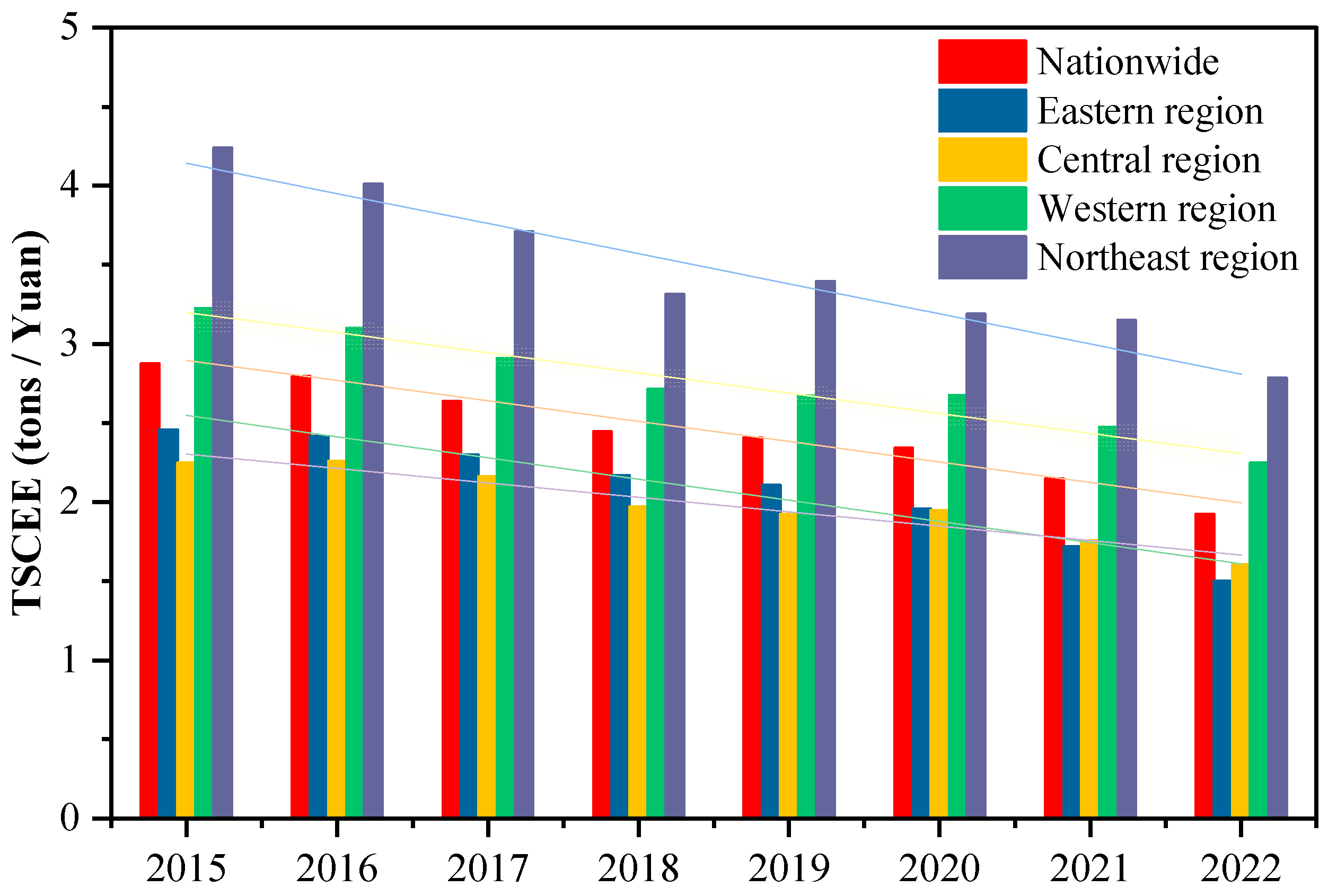

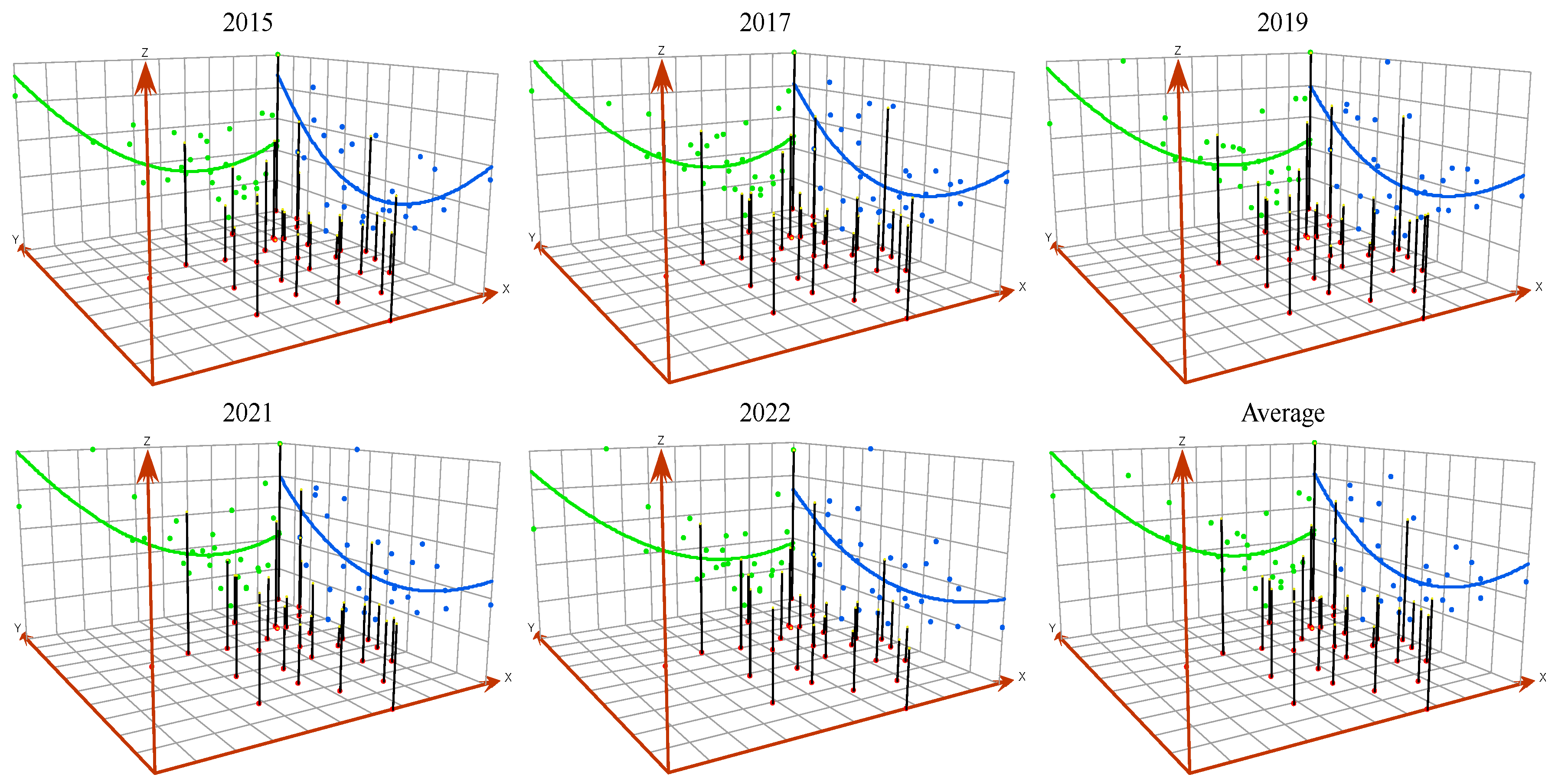
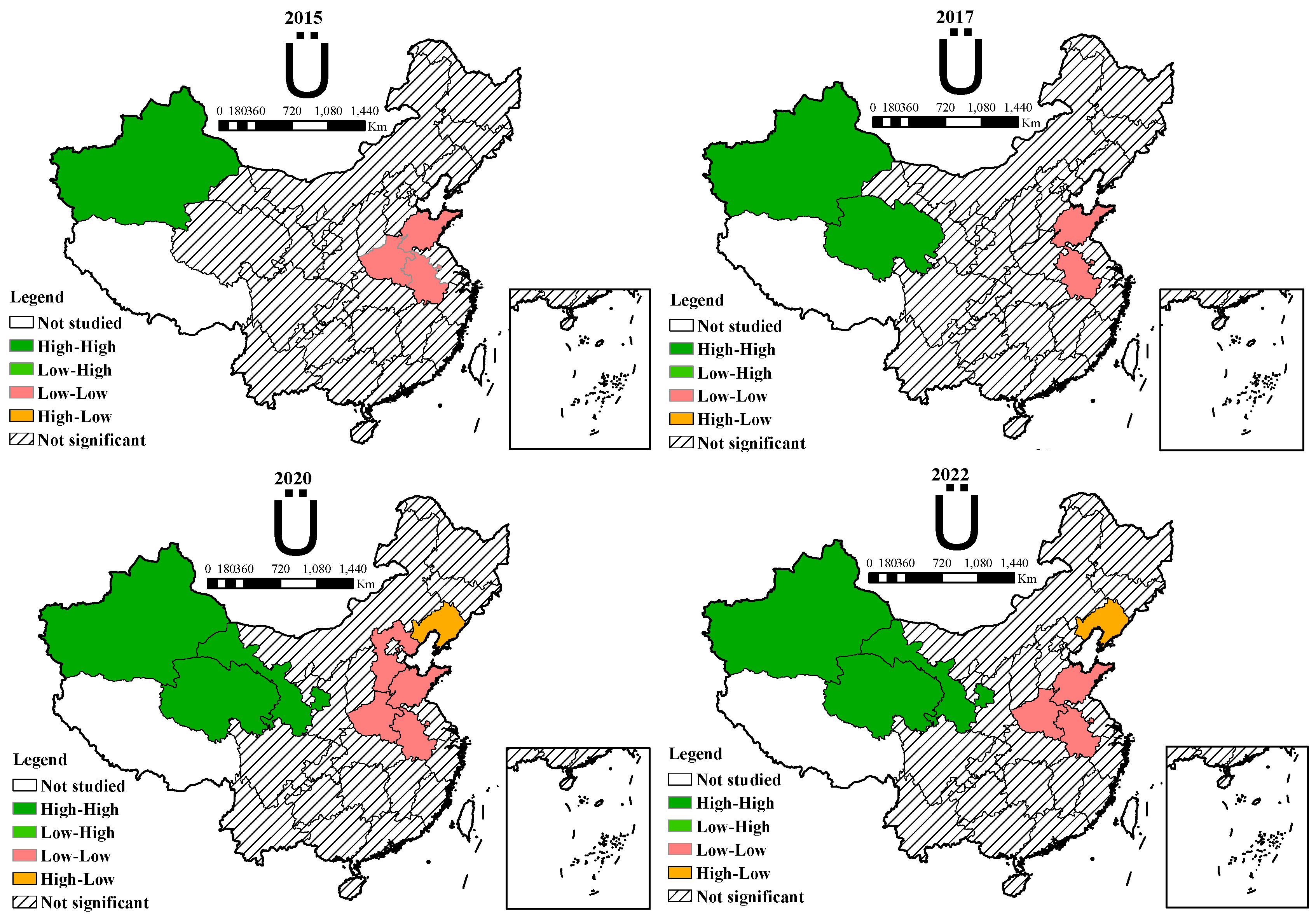
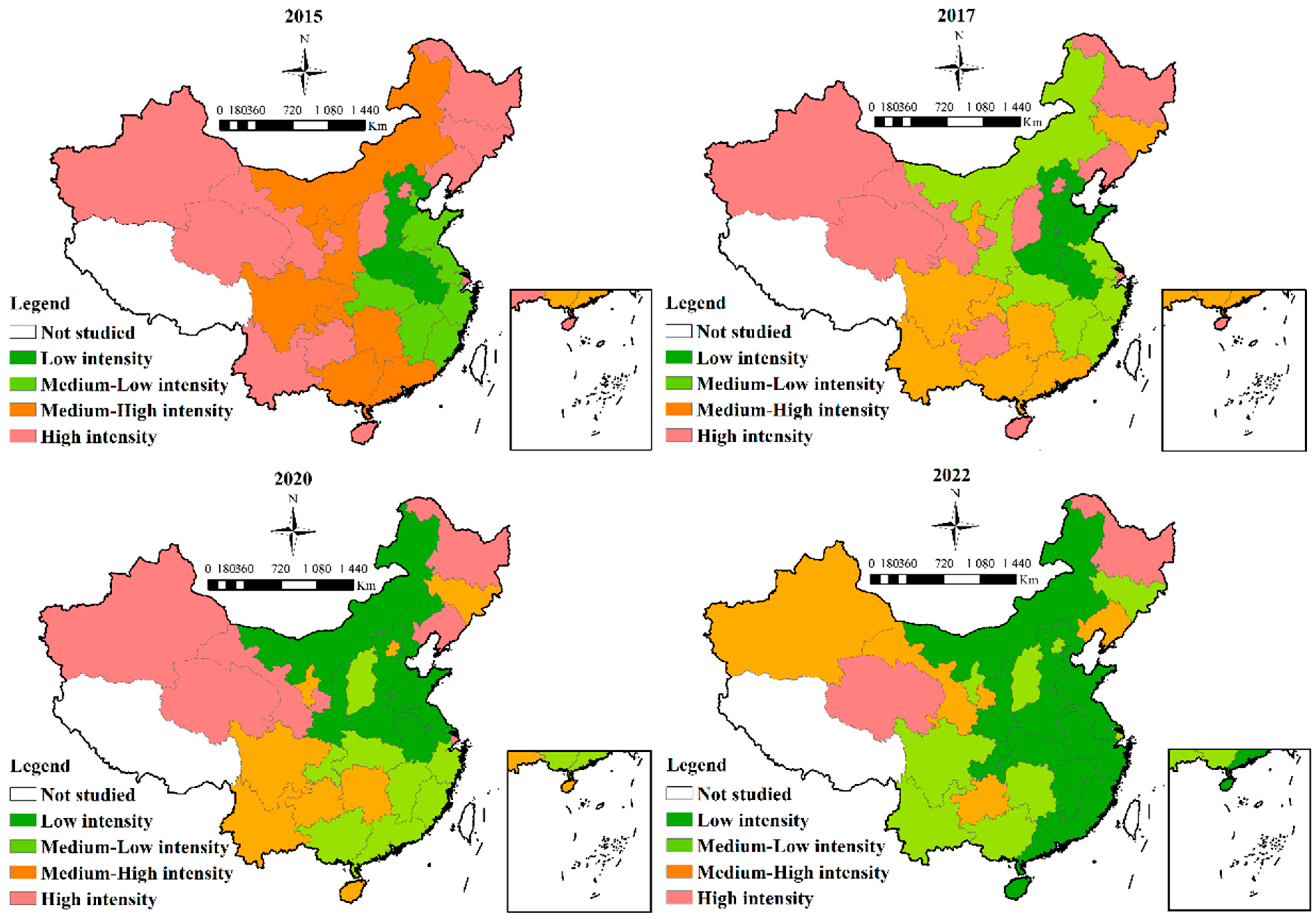
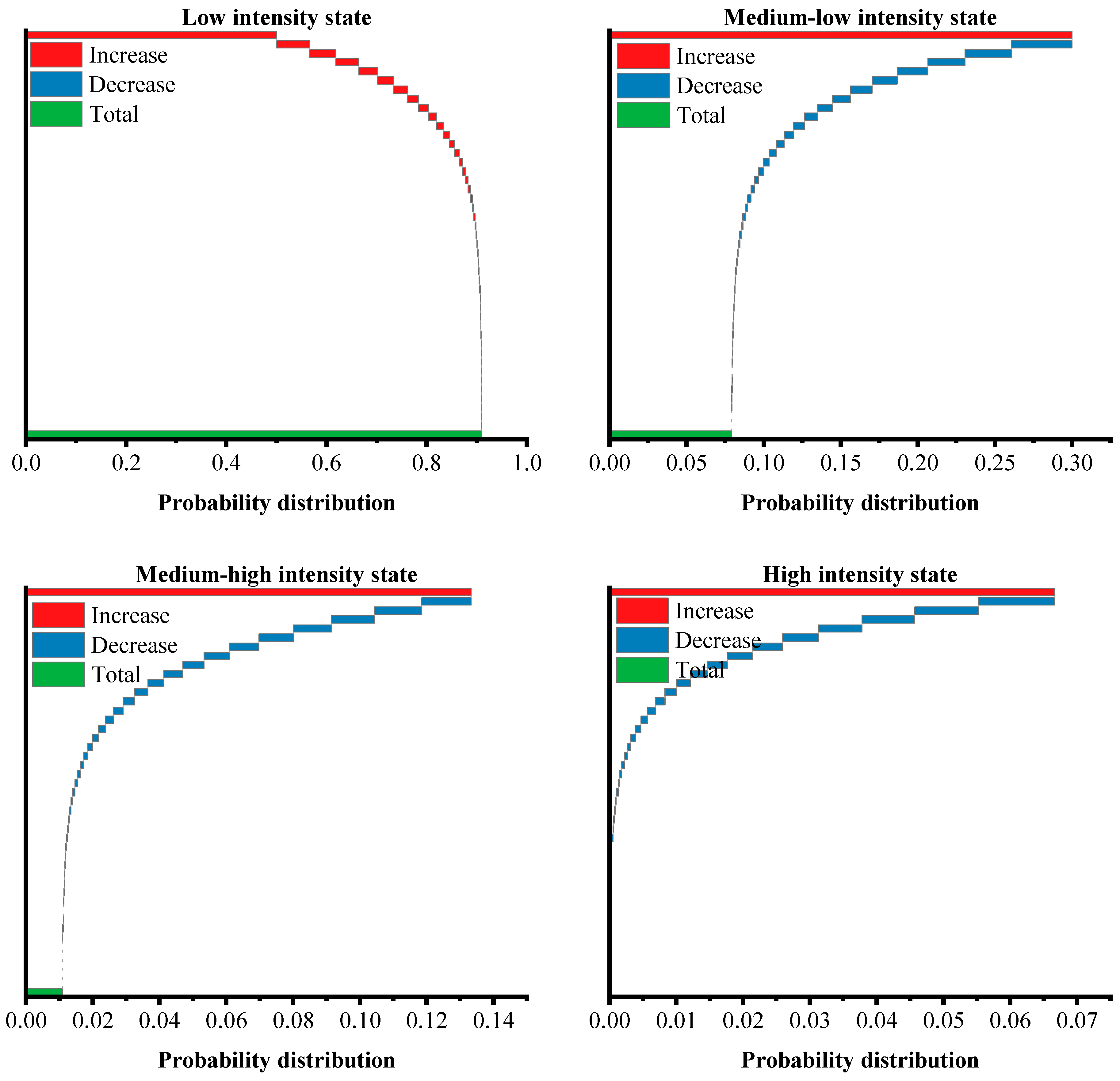
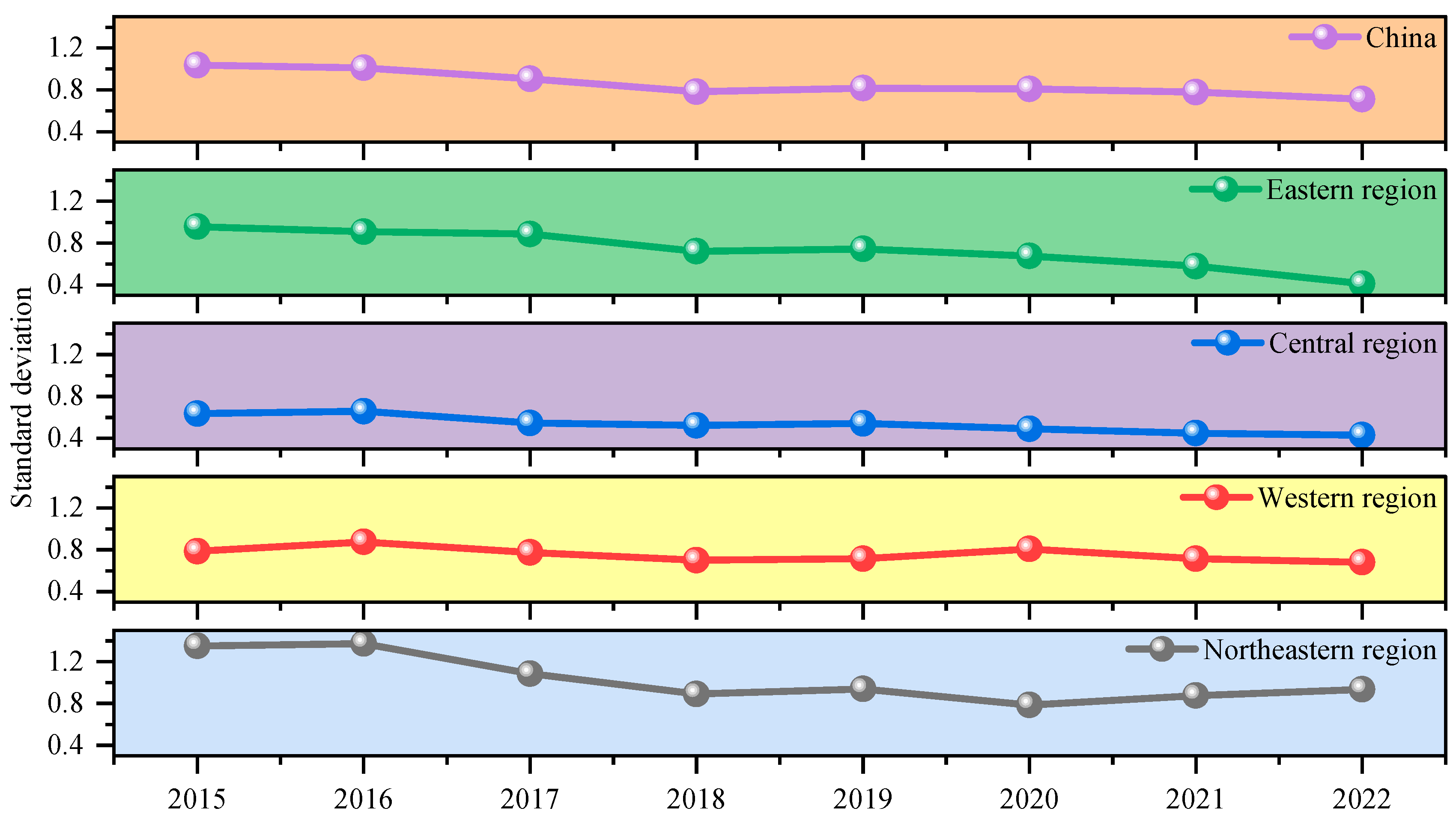
| Factor | Code | Explanatory | Unit |
|---|---|---|---|
| Economic growth [68] | GDP | Per capita GDP | 104 CNY/person |
| Industrial structure [69] | IND | Proportion of the value added of the tertiary industry to the secondary industry | % |
| Urbanization rate [17] | URB | Proportion of urban permanent population to total population | % |
| Transportation structure [18] | TRS | Proportion of railway and waterways freight traffic to total freight traffic | % |
| Transportation energy structure [70] | ENS | Proportion of electricity consumption to total energy consumption | % |
| Technological progress [18] | TEC | Ratio of industrial value added to total energy consumption | CNY 104/Tce |
| Variables | Maximum | Minimum | Medium | Average | Standard Deviation | Skewness | Kurtosis | Number |
|---|---|---|---|---|---|---|---|---|
| TSCEI | 5.6926 | 0.8278 | 2.3301 | 2.4468 | 0.9018 | 0.7933 | 3.5193 | 210 |
| GDP | 3.0578 | 0.5363 | 0.9088 | 1.1197 | 0.5340 | 2.0662 | 7.1152 | 210 |
| IND | 5.2440 | 0.7510 | 1.3086 | 1.4898 | 0.7709 | 3.3017 | 14.6388 | 210 |
| URB | 0.8933 | 0.4293 | 0.6099 | 0.6266 | 0.1071 | 0.8429 | 3.3692 | 210 |
| TRS | 0.7719 | 0.0149 | 0.1973 | 0.2321 | 0.1527 | 1.0402 | 3.8412 | 210 |
| ENS | 0.2055 | 0.0153 | 0.0512 | 0.0631 | 0.0358 | 1.7059 | 5.8618 | 210 |
| TEC | 3.9204 | 0.4119 | 1.0264 | 1.1404 | 0.5358 | 2.1425 | 10.1694 | 210 |
| Year | Overall Differences | Intra-regional Differences | Inter-Regional Differences | ||||||||
|---|---|---|---|---|---|---|---|---|---|---|---|
| E | C | W | N | E-C | E-W | E-N | C-W | C-N | W-N | ||
| 2015 | 0.1966 | 0.2041 | 0.1382 | 0.1268 | 0.1401 | 0.1866 | 0.2039 | 0.2874 | 0.2037 | 0.3133 | 0.1805 |
| 2016 | 0.1971 | 0.1958 | 0.1457 | 0.151 | 0.1475 | 0.1825 | 0.2041 | 0.275 | 0.2001 | 0.2875 | 0.1854 |
| 2017 | 0.1884 | 0.2006 | 0.1279 | 0.1398 | 0.129 | 0.1737 | 0.2015 | 0.2641 | 0.1857 | 0.271 | 0.1704 |
| 2018 | 0.1763 | 0.1767 | 0.1343 | 0.1341 | 0.1186 | 0.1707 | 0.1822 | 0.2351 | 0.1857 | 0.2602 | 0.1567 |
| 2019 | 0.1853 | 0.1837 | 0.142 | 0.1381 | 0.1228 | 0.1783 | 0.1911 | 0.2562 | 0.1914 | 0.2777 | 0.1689 |
| 2020 | 0.1886 | 0.1849 | 0.1258 | 0.1585 | 0.1078 | 0.1661 | 0.2102 | 0.2562 | 0.1929 | 0.2459 | 0.1597 |
| 2021 | 0.1972 | 0.1762 | 0.1302 | 0.1507 | 0.1229 | 0.1642 | 0.221 | 0.3048 | 0.1976 | 0.2868 | 0.1753 |
| 2022 | 0.1958 | 0.1417 | 0.1377 | 0.1558 | 0.1488 | 0.1498 | 0.223 | 0.3098 | 0.1998 | 0.2806 | 0.1867 |
| Average | 0.1907 | 0.1830 | 0.1352 | 0.1444 | 0.1297 | 0.1715 | 0.2046 | 0.2736 | 0.1946 | 0.2779 | 0.1730 |
| Year | Overall Differences | Intra-Regional Differences | Inter-Regional Differences | Transvariation Density | |||
|---|---|---|---|---|---|---|---|
| Source | Contribution (%) | Source | Contribution (%) | Source | Contribution (%) | ||
| 2015 | 0.1966 | 0.0449 | 22.84 | 0.1101 | 56.02 | 0.0416 | 21.14 |
| 2016 | 0.1971 | 0.0482 | 24.43 | 0.0992 | 50.30 | 0.0498 | 25.27 |
| 2017 | 0.1884 | 0.0462 | 24.51 | 0.0935 | 49.60 | 0.0488 | 25.90 |
| 2018 | 0.1763 | 0.0434 | 24.61 | 0.0906 | 51.37 | 0.0423 | 24.02 |
| 2019 | 0.1853 | 0.0448 | 24.16 | 0.0977 | 52.74 | 0.0428 | 23.11 |
| 2020 | 0.1886 | 0.0472 | 25.01 | 0.0967 | 51.30 | 0.0447 | 23.69 |
| 2021 | 0.1972 | 0.0451 | 22.88 | 0.1154 | 58.52 | 0.0367 | 18.60 |
| 2022 | 0.1958 | 0.0435 | 22.22 | 0.1201 | 61.35 | 0.0322 | 16.43 |
| Average | 0.1907 | 0.0454 | 23.83 | 0.1029 | 53.90 | 0.0424 | 22.27 |
| 2015 | 2016 | 2017 | 2018 | 2019 | 2020 | 2021 | 2022 | |
|---|---|---|---|---|---|---|---|---|
| Moran’ I | 0.2018 | 0.1702 | 0.1833 | 0.2100 | 0.1925 | 0.3197 | 0.3084 | 0.2868 |
| E(I) | −0.0345 | −0.0345 | −0.0345 | −0.0345 | −0.0345 | −0.0345 | −0.0345 | −0.0345 |
| Sd(I) | 0.1215 | 0.1236 | 0.1227 | 0.1228 | 0.1221 | 0.1220 | 0.1218 | 0.1202 |
| Z-score | 1.9458 | 1.6560 | 1.7748 | 1.9914 | 1.8589 | 2.9023 | 2.8147 | 2.6718 |
| p-value | 0.0517 * | 0.0977 * | 0.0759 * | 0.0464 ** | 0.0630 * | 0.0037 *** | 0.0049 *** | 0.0075 *** |
| Type | N | 1 | 2 | 3 | 4 |
|---|---|---|---|---|---|
| 1 | 45 | 0.8791 | 0.1209 | 0.0000 | 0.0000 |
| 2 | 51 | 0.1556 | 0.7556 | 0.0889 | 0.0000 |
| 3 | 56 | 0.0000 | 0.1348 | 0.7640 | 0.1011 |
| 4 | 58 | 0.0000 | 0.0000 | 0.1333 | 0.8667 |
| Neighborhoods | Type | N | 1 | 2 | 3 | 4 |
|---|---|---|---|---|---|---|
| 1 | 1 | 17 | 1.0000 | 0.0000 | 0.0000 | 0.0000 |
| 2 | 6 | 0.5000 | 0.5000 | 0.0000 | 0.0000 | |
| 3 | 5 | 0.0000 | 0.6000 | 0.4000 | 0.0000 | |
| 4 | 12 | 0.0000 | 0.0000 | 0.2500 | 0.7500 | |
| 2 | 1 | 22 | 0.9545 | 0.0455 | 0.0000 | 0.0000 |
| 2 | 30 | 0.2667 | 0.7000 | 0.0333 | 0.0000 | |
| 3 | 9 | 0.0000 | 0.4444 | 0.5556 | 0.0000 | |
| 4 | 14 | 0.0000 | 0.0000 | 0.0714 | 0.9286 | |
| 3 | 1 | 6 | 1.0000 | 0.0000 | 0.0000 | 0.0000 |
| 2 | 12 | 0.1667 | 0.7500 | 0.0833 | 0.0000 | |
| 3 | 30 | 0.0000 | 0.2333 | 0.7667 | 0.0000 | |
| 4 | 13 | 0.0000 | 0.0000 | 0.2308 | 0.7692 | |
| 4 | 1 | 0 | 0.0000 | 0.0000 | 0.0000 | 0.0000 |
| 2 | 3 | 0.0000 | 1.0000 | 0.0000 | 0.0000 | |
| 3 | 12 | 0.0000 | 0.1667 | 0.8333 | 0.0000 | |
| 4 | 19 | 0.0000 | 0.0000 | 0.1579 | 0.8421 |
| I | II | III | IV | |||
|---|---|---|---|---|---|---|
| Initial state (Year = 2022) | 0.5000 | 0.3000 | 0.1333 | 0.0667 | ||
| No | Ultimate state (Year) | 0.9098 | 0.0793 | 0.0109 | 0.0000 | |
| Consider | Ultimate state (Year) | I | 1.0000 | 0.0000 | 0.0000 | 0.0000 |
| II | 0.8451 | 0.1441 | 0.0108 | 0.0000 | ||
| III | 1.0000 | 0.0000 | 0.0000 | 0.0000 | ||
| IV | 0.0000 | 1.0000 | 0.0000 | 0.0000 | ||
| China | Eastern Region | Central Region | Western Region | Northeastern Region | |
|---|---|---|---|---|---|
| _Cons | 1.0545 *** | 1.0609 *** | 0.0670 *** | 0.8329 *** | 1.3643 *** |
| (31.34) | (32.97) | (26.91) | (20.35) | (13.38) | |
| −0.0441 *** | −0.0715 *** | −0.0314 *** | −0.0168 * | −0.0746 ** | |
| (−8.76) | (−8.98) | (−8.54) | (−2.42) | (−3.50) | |
| R2 | 0.8518 | 0.9365 | 0.8941 | 0.3942 | 0.6761 |
| China | Eastern Region | Central Region | Western Region | Northeastern Region | |
|---|---|---|---|---|---|
| Mode type | SDM | SDM | SEM | OLS | SAR |
| −0.4595 *** | −0.4954 *** | −0.4169 *** | −0.4989 ** | −0.4420 ** | |
| (−8.14) | (−4.05) | (−4.80) | (−3.04) | (−2.41) | |
| 0.1667 * | 0.2450 ** | 0.0443 | — | −0.3537 * | |
| (1.90) | (2.23) | (0.25) | (−1.84) | ||
| (%) | 0.0879 | 0.0977 | 0.0771 | 0.0987 | 0.0833 |
| LM-Error | 18.109 *** | 18.791 *** | 11.237 *** | 0.847 | 4.962 ** |
| Robust-LM-Error | 5.307 ** | 4.401 ** | 1.661 | 0.747 | 0.686 |
| LM-Lag | 17.175 *** | 17.397 *** | 11.081 *** | 0.816 | 4.969 ** |
| Robust-LM-Lag | 4.374 ** | 3.008 * | 1.505 | 0.716 | 0.693 ** |
| Time-fixed | Yes | Yes | Yes | Yes | Yes |
| Individual-fixed | Yes | Yes | Yes | Yes | Yes |
| Hausman | 62.53 *** | 14.06 *** | 12.68 *** | 7.96 *** | 6.37 ** |
| R2 | 0.0982 | 0.1130 | 0.0172 | 0.4256 | 0.0351 |
| China | Eastern Region | Central Region | Western Region | Northeastern Region | |
|---|---|---|---|---|---|
| Mode type | SEM | OLS | OLS | OLS | OLS |
| −0.9666 *** | −0.9815 *** | −0.9167 | −0.9807 *** | −0.7901 *** | |
| (−50.45) | (−30.47) | (−64.43) | (−28.87) | (−6.69) | |
| 0.3711 *** | — | — | — | — | |
| (4.14) | |||||
| GDP | −0.0718 | 0.0529 | 0.0335 | 0.2248 | 0.3014 |
| (−1.08) | (0.42) | (0.47) | (1.10) | (0.77) | |
| IND | −0.0694 ** | −0.1799 * | −0.0318 | −0.0755 | −0.0326 |
| (−2.54) | (−2.19) | (−1.18) | (−0.90) | (−0.15) | |
| URB | 0.1827 * | 0.6070 | 0.1628 | 0.7938 ** | −0.9203 |
| (1.89) | (1.50) | (0.50) | (2.42) | (−1.46) | |
| TRS | −0.0002 | 0.0026 | 0.0140 | −0.0042 | −0.0222 |
| (−0.03) | (0.13) | (0.83) | (−0.20) | (−0.50) | |
| ENS | −0.1282 *** | −0.1114 * | −0.1807 *** | −0.1406 *** | −0.1736 *** |
| (−11.67) | (−2.46) | (−12.81) | (−4.00) | (−6.61) | |
| TEC | −0.9215 *** | −0.9185 *** | −1.0335 *** | −0.9627 *** | −1.0548 *** |
| (−41.55) | (−15.98) | (−52.21) | (−19.82) | (−21.08) | |
| (%) | 0.4856 | 0.5700 | 0.3550 | 0.5640 | 0.2230 |
| LM-Error | 28.715 *** | 0.079 | 0.132 | 0.000 | 0.088 |
| Robust-LM-Error | 28.882 *** | 2.528 | 0.037 | 1.025 | 0.855 |
| LM-Lag | 1.724 | 10.563 *** | 0.981 | 4.017 ** | 2.045 |
| Robust-LM-Lag | 1.891 | 13.012 *** | 0.886 | 5.042 ** | 2.812 * |
| Time-fixed | Yes | Yes | Yes | Yes | No |
| Individual-fixed | Yes | Yes | Yes | Yes | No |
| Hausman | 42.08 *** | 40.07 *** | 16.72 *** | 32.48 *** | 0.85 |
| R2 | 0.8938 | 0.9730 | 0.9919 | 0.9567 | 0.9571 |
Disclaimer/Publisher’s Note: The statements, opinions and data contained in all publications are solely those of the individual author(s) and contributor(s) and not of MDPI and/or the editor(s). MDPI and/or the editor(s) disclaim responsibility for any injury to people or property resulting from any ideas, methods, instructions or products referred to in the content. |
© 2025 by the authors. Licensee MDPI, Basel, Switzerland. This article is an open access article distributed under the terms and conditions of the Creative Commons Attribution (CC BY) license (https://creativecommons.org/licenses/by/4.0/).
Share and Cite
Peng, Z.; Li, M. Carbon Emissions Intensity of the Transportation Sector in China: Spatiotemporal Differentiation, Trends Forecasting and Convergence Characteristics. Sustainability 2025, 17, 815. https://doi.org/10.3390/su17030815
Peng Z, Li M. Carbon Emissions Intensity of the Transportation Sector in China: Spatiotemporal Differentiation, Trends Forecasting and Convergence Characteristics. Sustainability. 2025; 17(3):815. https://doi.org/10.3390/su17030815
Chicago/Turabian StylePeng, Zhimin, and Miao Li. 2025. "Carbon Emissions Intensity of the Transportation Sector in China: Spatiotemporal Differentiation, Trends Forecasting and Convergence Characteristics" Sustainability 17, no. 3: 815. https://doi.org/10.3390/su17030815
APA StylePeng, Z., & Li, M. (2025). Carbon Emissions Intensity of the Transportation Sector in China: Spatiotemporal Differentiation, Trends Forecasting and Convergence Characteristics. Sustainability, 17(3), 815. https://doi.org/10.3390/su17030815






